Stupa
| Translations of Stupa | |
|---|---|
| English | Stupa |
| Sanskrit | स्तूप |
| Pali | 𑀣𑀼𑀩𑁂 ( "thube" ), thūpa |
| Bengali | স্তূপ (st̪up) |
| Burmese | စေတီ (MLCTS:zèdì) |
| Chinese | Tốt đổ sườn núi (Pinyin:sūdǔpō) |
| Japanese | Tốt tháp bà (Rōmaji:sotoba) |
| Khmer | ចេតិយ, ស្តូប (UNGEGN:chétĕy, stob) |
| Korean | 솔도파 (RR:soldopha) |
| Mongolian | суварга (suvarga) |
| Sinhala | දාගැබ් (dagab) |
| Tibetan | མཆོད་རྟེན་ (mchod rten (chorten)) |
| Tamil | தாது கோபுரம் |
| Thai | สถูป, เจดีย์ (RTGS:sa thup, chedi) |
| Vietnamese | Phù đồ, bảo tháp |
| Glossary of Buddhism | |
In Buddhism, astupa(Sanskrit:स्तूप,lit. 'heap',IAST:stūpa) is amound-like or hemispherical structure containing relics (such asśarīra– typically the remains ofBuddhist monksornuns) that is used as a place ofmeditation.[1]
Circumambulation,orpradakhshina,has been an important ritual and devotional practice in Buddhism since the earliest times, and stupas always have apradakhshinapath around them. The originalSouth Asianform is a large solid dome above atholobate,or drum, with vertical sides, which usually sits on a square base. There is no access to the inside of the structure. In large stupas, there may be walkways for circumambulation on top of the base as well as on the ground below it. Large stupas have, or had,vedikārailings outside the path around the base, often highly decorated with sculpture, especially at thetoranagateways, of which there are usually four. At the top of the dome is a thin vertical element, with one or more horizontal discs spreading from it. These werechatras,symbolic umbrellas, and have not survived, if not restored. TheGreat Stupa at Sanchi,Madhya Pradesh, is the most famous and best-preserved early stupa in India.
Apart from very large stupas, designed to attract pilgrims, there were large numbers of smaller stupas in a whole range of sizes, which typically had much taller drums, relative to the height of the dome. Small votive stupas paid for by pilgrims might be less than a metre high, and laid out in rows by the hundred, as atRatnagiri, Odisha,India.
As Buddhism spread, other forms were used for the same purposes, and thechortensofTibetan BuddhismandpagodasofEast Asian Buddhismare some of these. InSoutheast Asia,various rather different elongated shapes of dome evolved, leading to high, thinspires.A related architectural term is achaitya,which is a prayer hall or temple containing a stupa.
Description and history[edit]
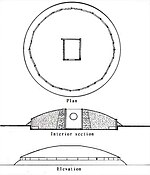
Stupas may have originated as pre-Buddhisttumuliin whichśramaṇaswere buried in a seated position,[2]calledcaitya.[3]
In early Buddhist inscriptions in India,stupaandcaityaappear to be almost interchangeable, thoughcaityahas a broader meaning, and unlikestupadoes not define anarchitectural form.In pre-Buddhist India,caityawas a term for a shrine, sanctuary, or holy place in the landscape, generally outdoors, inhabited by, or sacred to, a particular deity. In theMahāyāna Mahāparinirvāṇa Sūtra,near the end of his life, the Buddha remarks toAnandahow beautiful are the variouscaityaaroundVaishali.[4]In later times and in other countries,cetiya/caitya implies the presence of important relics. Both words have forms prefixed bymahafor "great", "large", or "important", but scholars find the difference between amahastupaand astupa,ormahacetiyaandcetiya,hard to pin down.[5]
Some authors have suggested that stupas were derived from a wider cultural tradition from theMediterraneanto theGanges Valley[6]and can be related to the conical mounds on circular bases from the 8th century BCE that are found inPhrygia(tomb ofMidas,8th c. BCE),Lydia(tomb ofAlyattes,6th c. BCE), or inPhoenicia(tombs ofAmrit,5th c. BCE).[7][8]Some authors suggest stupas emerged frommegalithicmound burials with chambers, which likely represent proto-stupas.[9][10][11]
Archaeologists in India have observed that a number of early Buddhist stupas or burials are found in the vicinity of much older, pre-historic burials, including megalithic burial sites.[10]This includes sites associated with theIndus Valley Civilization,where broken Indus-era pottery was incorporated into later Buddhist burials.[10]Scholars have noted structural and functional features of the stupa (including its general mound shape and the practice of surrounding stupas with a stone, relic chamber, or wooden railing) with both pre-Mauryan-eracairn and pre-historic megalithic "round mound" burials with chambers found in India, which likely represent a "proto-stupa".[12][10]InDholavira,an archeological site associated with the Indus Valley Civilization, there are several large and high "hemispherical monuments" of tumulus with brick-masonry found with burial chambers inside. Among them, Tumulus-1 and Tumulus-2 mounds were excavated. They consist of a deep and wide rock-cut chamber, surrounded on the ground by a massive circular mud-brick structure made in two tiers, and filled in and topped with earth to form a domical shape.[13]There is also evidence of plastering on the exterior of Tumulus-1, bearing a 10- mm-thickplasterof pinkish-white clay over brick masonry.[13]These forms of hemispherical monuments or tumulus of brick-masonry with similar layouts may have been inspirations for later stupas.[11]Some stupas not believed to have been looted have been found empty when excavated, as have some pre-historic cairn sites, and animal bones are suspected to have occasionally been deposited at both types of sites.[10]
Mounds for the relics of the Buddha (5th century BCE)[edit]


Religious buildings in the form of the Buddhist stupa, a dome-shaped structure, started to be used in India as commemorative monuments associated with storing sacred relics of the Buddha.[14]After hisparinirvana,Buddha's remains were cremated and the ashes divided and buried under eight mounds, with two further mounds encasing the urn and the embers.[14]
According to some early Buddhist sources, the Buddha himself had suggested this treatment, and when asked what a stupa was, had demonstrated the basic design: he folded his robe on the ground, placed his begging bowl upside down on it, with his staff above that.[15]
The relics of the Buddha were spread between eight stupas, inRajagriha,Vaishali,Kapilavastu,Allakappa,Ramagrama,Pava,Kushinagar,andVethapida.[16]ThePiprahwastupa also seems to have been one of the first to be built.[16] Lars Fogelin has stated that the Vaishali andNigali Sagarstupas are likely the earliest archaeologically known stupas.[17][18]
Guard rails—consisting of posts, crossbars, and acoping—became a feature of safety surrounding a stupa.[19]The Buddha had left instructions about how to pay homage to the stupas: "And whoever lays wreaths or puts sweet perfumes and colours there with a devout heart, will reap benefits for a long time".[20]This practice would lead to the decoration of the stupas with stone sculptures of flower garlands in the Classical[clarification needed]period.[20]
Expansion under Ashoka (250 BCE)[edit]
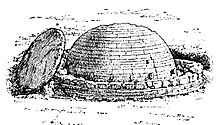
According to Buddhist tradition, EmperorAshoka(rule: 273–232 BCE) recovered the relics of the Buddha from the earlier stupas (except from theRamagrama stupa), and erected 84,000 stupas to distribute the relics across India. In effect, many stupas are thought to date originally from the time of Ashoka, such asSanchiorKesariya,where he also erected pillars with his inscriptions, and possiblyBharhut,Amaravati,orDharmarajika.[16]Ashoka also established thePillars of Ashokathroughout his realm, generally next to Buddhist stupas.
The first known appearance of the word "stupa" is froman inscribed dedicationby Ashoka on theNigali Sagarpillar (spelled inPaliin theBrahmi scriptas 𑀣𑀼𑀩𑁂thube).[22]
Decorated stupas (from 125 BCE)[edit]
Stupas were soon to be richly decorated with sculptural reliefs, following the first attempts atSanchi Stupa No.2(125 BCE). Full-fledged sculptural decorations and scenes of the life of the Buddha would soon follow at Bharhut (115 BCE),Bodh Gaya(60 BCE),Mathura(125–60 BCE), again at Sanchi for the elevation of thetoranas(1st century BCE/CE), and then Amaravati (1st–2nd century CE).[23]The decorative embellishment of stupas also underwent considerable development in the northwest, in the area ofGandhara,with instances such as theButkara Stupa( "monumentalized" withHellenisticdecorative elements from the 2nd century BCE)[24]or theLoriyan Tangai stupas(2nd century CE).
-
Sanchi Stupa No.2,the earliest known stupa with important displays of decorative reliefs, c. 125 BCE[25]
-
Amaravati Stupa,1st-2nd century CE
Development in Gandhara (3rd century BCE–5th century CE)[edit]
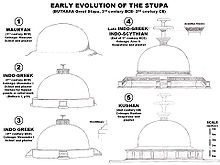
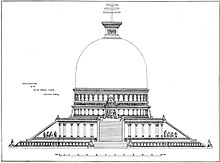

The stupa underwent major evolutions in the area of Gandhara. Since Buddhism spread toCentral Asia,China, and ultimately Korea and Japan through Gandhara, the stylistic evolution of the Gandharan stupa was very influential in the later development of the stupa (and related artistic orarchitectural forms) in these areas.[27]The Gandhara stupa followed several steps, generally moving towards more and more elevation and addition of decorative elements, leading eventually to the development of thepagodatower.[28]The main stupa types are, in chronological order:
- TheDharmarajika Stupa,with a near-Indian design of a semi-hemispheric stupa almost directly on the ground surface, probably dated to the 3rd century BCE. Similar stupas are theButkara Stupa,theManikyalastupa, or the Chakpat stupa.[21]
- TheSaidu Sharif Stupa,pillared andquincunxial,with a flight of stairs to a dome elevated on a square platform. Many Gandhara miniatures represent this type (1st century CE).[29]
- TheLoriyan Tangaistupa, with an elongated shape and many narrative reliefs, in many ways the classic Gandharan stupa (2nd century CE).[30]
- The near-pyramidalJaulianstupa (2nd century CE).[31]
- Thecruciformtype, as in theBhamala Stupa,with flights of stairs in the four cardinal directions (4th century CE).[32]
- The towering design of the secondKanishka Stupa(4th–5th century CE).[33]
-
A model resembling theSaidu Sharif Stupa,with square base and four columns (1st century CE).[29]
-
Loriyan Tangaidecorated stupa, in theGreco-Buddhist artof Gandhara (2nd century CE).
-
A tower-shaped stupa, thought to be the design of the second (rebuilt)Kanishka Stupa,Jaulianmonastery[33]
-
Stupa-shaped reliquary,Kushanperiod, about 2nd century CE
Origin of the pyramidal temple[edit]
It is thought that the temple in the shape of a truncated pyramid may have derived from the design of the stepped stupas that developed in Gandhara. TheMahabodhi Templein Bodh Gaya is one such example, formed of a succession of steps with niches containing Buddha images, alternating with Greco-Roman pillars.[35]The structure is crowned by the shape of a hemispherical stupa topped byfinials,forming a logical elongation of the stepped Gandharan stupas such as those seen inJaulian.[35]
Although the current structure of the Mahabdhodi Temple dates to theGuptaperiod (5th century CE), the "Plaque of Mahabhodi Temple", discovered inKumraharand dated to 150–200 CE, based on its datedKharoshthiinscriptions and combined finds ofHuvishkacoins, suggests that the pyramidal structure already existed in the 2nd century CE.[35]This is confirmed by archaeological excavations in Bodh Gaya.[35]
This truncated pyramid design also marked the evolution from theaniconicstupa dedicated to the cult of relics, to theiconictemple with multiple images of the Buddha and Bodhisattvas.[35]This design was influential in the development of laterHindu temples.[36]
Expansion in Asia[edit]
Asian stupas[edit]


Stupa architecture was adopted inSoutheastandEast Asia,where it became prominent as a Buddhist monument used for enshrining sacred relics.[14]The Indian gateway arches,torana,reached East Asia with the spread of Buddhism.[38]Some scholars hold thattoriiderives from the torana gates at the Buddhist historic site of Sanchi (3rd century BCE–11th century CE).[39]InTibet,the stupa became the chorten,[40]and the pagoda in East Asia.[41]The pagoda has varied forms that also include bell-shaped and pyramidal styles. In the Western context, there is no clear distinction between a stupa and a pagoda. In general, however, "stupa" is the term used for a Buddhist structure in India or Southeast Asia, while "pagoda" refers to a building in East Asia that can be entered and that may be used for secular purposes. However, use of the term varies by region. For example, stupas in Burma tend to be referred to as "pagodas".[citation needed]
Stupas were built inSri Lankasoon afterDevanampiya Tissa of Anuradhapuraconverted to Buddhism. The first was theThuparamaya.Later, many more were built over the years, including theJetavanaramayain Anuradhapura.
Development of the pagoda[edit]
The Asian words for pagoda (tāin Chinese,t'apin Korean,thápin Vietnamese,tōin Japanese) are all thought to derive from thePaliword for stupa,thupa,with theSanskritpronunciation beingstupa.[42]In particular the type of the tower-like stupa, the last stage of Gandharan stupa development, visible in the secondKanishka Stupa(4th century), is thought to be the precursor of the tower stupas inTurkestanand the Chinese pagodas such asSongyue Pagoda(523 CE).[37]
Notable stupas[edit]

The earliest archaeological evidence for the presence of Buddhist stupas dates to the late 4th century BCE. Some of the oldest known examples of stupas are found in Vaishali, Kushinagar, Piprahwa, Ramgram, Sanchi,Sarnath,Amaravati, and Bharhut.
With the top of its spire reaching 120.45 m (395.2 ft) in height,Phra Pathommachediin Nakhon Pathom, Thailand is the tallest extant stupa in the world.[43]TheSwat Valleyhosts a well-preserved stupa at Shingardar nearGhalegay;another stupa is located nearBarikotand Dharmarajika-Taxila in Pakistan. In Sri Lanka, the ancient city ofAnuradhapuraincludes some of the tallest, most ancient, and best-preserved stupas in the world, such asRuwanwelisaya.
The most elaborate stupa is the 8th-centuryBorobudurmonument in Java, Indonesia. The upper rounded terrace, with rows of bell-shaped stupas, contain Buddha images symbolizingArūpajhāna,the sphere of formlessness. The main stupa itself is empty, symbolizing complete perfection of enlightenment. The main stupa is the crown part of the monument, while the base is a pyramidal structure elaborated with galleries adorned withbas-reliefscenes derived from Buddhist texts and depicting the life ofGautama Buddha.Borobudur's unique and significant architecture has been acknowledged byUNESCOas the largest Buddhist monument in the world. It is also the world's largest Buddhist temple[44][45]as well as one of the greatest Buddhist monuments in the world.[46]

AJain stupawas excavated atMathurain the 19th century.[47]
TheShwedagon Pagodain Yangon, Myanmar, is one of the largest stupas in the world.
European stupas[edit]
TheBenalmádena Stupais the tallest stupa in Europe. It is 33 m (108 ft) high and was inaugurated on 5 October 2003, the final project of Buddhist masterLopon Tsechu Rinpoche.Lopon Tsechu built his first stupa atKarma Guennear Málaga, in 1994,[48]a symbol of peace and prosperity for Spain.[49]He went on to build 16 more stupas in Europe before his death in 2003.
A stupa was built on the ground of the Kalachakra Kalapa Centre in southwestStyria,Austria, between 2000 and 2002.
A stupa based on the bell-shaped stupas at Borobudur is located atAmaravati Buddhist Monastery,nearHemel Hempstead,in the UK.[50]
Types of stupas[edit]

Built for a variety of reasons, Buddhist stupas are classified, based on form and function, into five types:[51]
- Relic stupa,in which the relics or remains of the Buddha, his disciples, and lay saints are interred
- Object stupa,in which the items interred are objects that belonged to the Buddha or his disciples, such as a begging bowls or robes, or important Buddhist scriptures.
- Commemorative stupa,built to commemorate events in the lives of Buddha or his disciples
- Symbolic stupa,to symbolise aspects of Buddhist theology. For example, Borobudur is considered to be the symbol of "the Three Worlds (dhatu) and the spiritual stages (bhumi) in a Mahayanabodhisattva'scharacter ".[51]
- Votive stupa,constructed to commemorate visits or to gain spiritual benefits, usually at the site of prominent stupas that are regularly visited.
Symbolism[edit]

"The shape of the stupa represents the Buddha, crowned and sitting in meditation posture on a lion throne. His crown is the top of the spire; his head is the square at the spire's base; his body is the vase shape; his legs are the four steps of the lower terrace; and the base is his throne."[52]
Five purified elements[edit]
Although not described in any Tibetan text on stupa symbolism, the stupa may represent the five purified elements, according to Buddhism:[53]
- The square base represents Earth.
- The hemispherical dome/vase represents water.
- The conical spire represents fire.
- The upper lotus parasol and the crescent moon represent air.
- The sun and the dissolving point represent wisdom.
Construction[edit]
To build a stupa,Dharma transmissionand ceremonies known to aBuddhist teacherare necessary.[54]The type of stupa to be constructed in a certain area is decided together with the teacher assisting in the construction. Sometimes the type chosen is directly connected with events that have taken place in the area.[54]
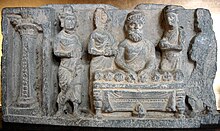

Treasury[edit]
All stupas contain a treasury filled with various objects. Small clay votive offerings calledtsatsas in Tibetan fill most of the treasury. The creation of thetsatsas is itself a ceremony. Mantras written on paper are made into thin rolls and put into small clay stupas.[54]One layer oftsatsas is placed in the treasury, and the empty space between them is filled with dry sand. On the thus-created new surface, another layer oftsatsas is made, and so on, until the entire space of the treasury is full.[54]
The number oftsatsas required to completely fill the treasury depends on its size and the size of thetsatsa. For example, theKalachakra stupain southern Spain contains approximately 14,000tsatsas.[54]
Jewellery and other "precious" objects are also placed in the treasury. It is not necessary that they be expensive, since it is the symbolic value that is important, not the market price.[54]It is believed that the more objects are placed in the stupa, the stronger its energy.[54]
Tree of Life[edit]
An important element in every stupa is the "Tree of Life".This is a wooden pole covered with gems and thousands of mantras; it is placed in the central channel of the stupa.[54]It is positioned during a ceremony or initiation, where the participants hold colorful ribbons connected to the Tree of Life. Together, the participants make their most positive and powerful wishes, which are stored in the Tree of Life. In this way, the stupa is charged and starts to function.[54]
Benefits[edit]
Building a stupa is considered extremely beneficial, leaving very positivekarmicimprints in the mind. Future benefits from this action are said to result in fortunate rebirths. Fortunate worldly benefits also result, such as being born into a rich family, having a beautiful body, a nice voice, bringing joy to others, and having a long and happy life in which one's wishes are quickly fulfilled.[55]On the absolute level, one will also be able to quickly reachenlightenment,the goal of Buddhism.[55]
Destroying a stupa, on the other hand, is considered an extremely negative deed, similar to murder.[56]Such an action is said to create massive negative karmic imprints, leading to serious future problems. It is said this action leaves the mind in a state of paranoia after death has occurred, leading to unfortunate rebirths.[56]
Tibetan stupas[edit]


Stupas inTibetand Tibetan-influenced regions of theHimalayas,such asBhutan,are usually called "chorten" in English, reflecting the term in theTibetan language.There are eight different shapes of chortens inTibetan Buddhism,each referring to a major event in the Buddha's life.[53]Chortens are often made as a set, placed in a row. The Tibetan set differs slightly (by two events) from the Indianset of Eight Great Events in the Life of Buddha.
Lotus Blossom Stupa[edit]
Also known as "Stupa of Heaped Lotuses", or "Birth of the Sugata Stupa", this stupa refers to the birth of Gautama Buddha. "At birth Buddha took seven steps in each of the four directions"[53](east, south, west, and north). In each direction, lotuses sprang up, symbolizing thebrahmaviharas:love, compassion, joy, and equanimity. The base of this stupa is circular and has four steps, and it is decorated with lotus-petal designs. Occasionally, seven heaped lotus steps are constructed. These refer to the seven first steps of the Buddha.[53]
Enlightenment Stupa[edit]

Also known as the "Stupa of the Conquest ofMara",this stupa symbolizes the 35-year-old Buddha's attainment of enlightenment under the bodhi tree inBodh Gaya,where he conquered worldly temptations and attacks, manifesting in the form of Mara.[53]
Stupa of Many Doors[edit]
This stupa is also known as the "Stupa of Many Gates". After reaching enlightenment, the Buddha taught his first students in a deer park nearSarnath.The series of doors on each side of the steps represents the first teachings: theFour Noble Truths,the SixPāramitās,theNoble Eightfold Path,and theTwelve Nidānas.[53]
Stupa of Descent from the God Realm[edit]
At 42 years of age, Buddha spent a summer retreat in theTuṣita Heaven,where his mother had taken rebirth. In order to repay her kindness, he taught the dharma to her rebirth. Local inhabitants built a stupa inSankassain order to commemorate this event. This type of stupa is characterized by having a central projection at each side, containing a triple ladder, or steps.[53]
Stupa of Great Miracles[edit]
Also known as the "Stupa of Conquest of theTirthikas",this stupa refers to various miracles performed by the Buddha when he was 50 years old. Legend claims that he overpoweredmarasand heretics by engaging them in intellectual arguments and also by performing miracles. This stupa was raised by theLichavikingdom to commemorate the event.[53]
Stupa of Reconciliation[edit]
This stupa commemorates the Buddha's resolution of a dispute among thesangha.A stupa in this design was built in the kingdom ofMagadha,where the reconciliation occurred. It has four octagonal steps with equal sides.[53]
Stupa of Complete Victory[edit]
This stupa commemorates Buddha's successful prolonging of his life by three months. It has only three steps, which are circular and unadorned.[53]
| Part ofa serieson |
| Buddhism |
|---|
 |
Stupa of Nirvana[edit]
This stupa refers to theparinirvana,or death of the Buddha, when he was 80 years old. It symbolizes his complete absorption into the highest state of mind. It is bell-shaped and usually unornamented.[53]
Kalachakra stupa[edit]
A ninth kind of stupa exists, theKalachakra stupa.Its symbolism is not connected to events in the Buddha's life but instead to the symbolism of theKalachakra Tantra,created to protect against negative energies.[57]
Gallery[edit]
-
An early stupa atGuntupalle,probablyMaurya Empire,third century BCE
-
Buddha statue inside a votive stupa,Sarnath
-
Abayagiri Dageba, Sri Lanka
-
Chorten nearPotala Palace,Lhasa, Tibet
-
The white stupa inMiaoying Temple,China
-
TheKalachakra stupain Karma Guen, Spain
Cambodia[edit]
-
Stupa of Kantha Bopha
-
Stupa of KingNorodom Suramarit
-
Main stupa atWat Phnom
-
Stupa atWat Botum
-
Stupa atOudong
-
Golden stupa atWat Ounalom
Kathmandu, Nepal[edit]
-
Roadside stupa; Kathmandu, 1979
-
BoudhanathStupa
-
Stupa
-
Tahiti stupa
-
Yetkha Stupa
-
Small stupa in Kathmandu street
See also[edit]
References[edit]
- ^encyclopedia.Credited to James Stevens Curl,A Dictionary of Architecture and Landscape Architecture,2000, originally published by Oxford University Press 2000.
- ^"Buddhist Art and Architecture: Symbolism of the Stupa / Chorten".14 August 2006.Retrieved7 January2013.
- ^"The Buddhist stupa: origin and development".13 January 2005.Retrieved7 January2013.
- ^Skilling (2016),p. 25.
- ^Skilling (2016),pp. 23–24.
- ^"It is probably traceable to a common cultural inheritance, stretching from the Mediterranean to the Ganges valley, and manifested by the sepulchres, conical mounds of earth on a circular foundation, of about the eighth century B.C. found inEritreaandLydia."Rao, P. R. Ramachandra (2002).Amaravati.Youth Advancement, Tourism & Cultural Department Government of Andhra Pradesh. p. 33.
- ^On the hemispherical Phenician tombs of Amrit:Coomaraswamy, Ananda K. (1972).History of Indian and Indonesian art.p.12.
- ^Commenting onGisbert Combaz:"In his study L'évolution du stupa en Asie, he even observed that" long before India, the classical Orient was inspired by the shape of the tumulus for constructing its tombs: Phrygia, Lydia, Phenicia. "inBénisti, Mireille; K, Thanikaimony (2003).Stylistics of Buddhist art in India.Indira Gandhi National Centre for the Arts. p. 12.ISBN9788173052415.
- ^M. Menon, Srikumar (16 September 2016)."The 'Round Mound' and its Structural Requirements: A Possible Scenario for the Evolution of the Form of the Stupa"(PDF).National Institute of Advanced Studies.Retrieved16 September2016.
- ^abcdeSchopen, Gregory. 2004. Buddhist Monks & Business Matters, pp. 361–374
- ^abSingh Bisht, Ravindra."How the Harappans Honoured Death at Dholavira – Chapter VI. Hemispherical monument or tumulus".Archaeological Survey of India:252–305.Retrieved21 March2011.
- ^M. Menon, Srikumar (16 September 2016)."The" Round Mound "and its Structural Requirements: A Possible Scenario for the Evolution of the Form of the Stupa"(PDF).National Institute of Advanced Studies.Retrieved16 September2016.
- ^abSingh Bisht, Ravindra."How the Harappans Honoured Death at Dholavira – Chapter VI. Hemispherical monument or tumulus".Archaeological Survey of India:271–284.Retrieved21 March2011.
- ^abcEncyclopædia Britannica (2008),Pagoda.
- ^Soekmono, Dr,Chandi Borobudur: A Monument of Mankind,p. 39, 1976, Paris: Unesco Press.ISBN92-3-101292-4,Full PDF
- ^abcLe (2010),pp. 140–174.
- ^Fogelin, Lars (2015).An Archaeological History of Indian Buddhism.Oxford University Press. p. 85.ISBN9780199948239.
- ^Lahiri, Nayanjot (2015).Ashoka in Ancient India.Harvard University Press. pp. 246–247.ISBN9780674057777.
- ^Chandra (2008).
- ^abLe (2010),p. 143.
- ^abLe (2010),p. 173.
- ^Skilling (2016),p. 23.
- ^abcLe (2010),pp. 149–150.
- ^"De l'Indus a l'Oxus: archaeologie de l'Asie Centrale", Pierfrancesco Callieri, p. 212: "The diffusion, from the second century BCE, of Hellenistic influences in the architecture ofSwatis also attested by the archaeological searches at the sanctuary ofButkara I,which saw its stupa "monumentalized" at that exact time by basal elements and decorative alcoves derived fromHellenistic architecture".
- ^Didactic Narration: Jataka Iconography in Dunhuang with a Catalogue of Jataka Representations in China, Alexander Peter Bell, LIT Verlag Münster, 2000pp. 15ff
- ^World Heritage Monuments and Related Edifices in India, Volume 1 p. 50 by Alī Jāvīd, Tabassum Javeed, Algora Publishing, New York[1]
- ^Le (2010),p. 181.
- ^Le (2010),pp. 182–183.
- ^abLe (2010),pp. 174–176.
- ^Le (2010),pp. 176–177.
- ^Le (2010),p. 179.
- ^Le (2010),p. 178.
- ^abLe (2010),pp.179–180.
- ^Dated "between A.D. 300–350 based on Kharosthi, Brahmi, and Sodian inscriptions written before and after the drawing was completed (fig. 3). In the center of the triptych, a spectacular stupa with a relatively small dome [anda], a chattravali with seven disks, columns, banners, and multiple bells illustrates a trend towards decorative profusion.""Chital petroglyphs".Bulletin of the Asia Institute.Wayne State University Press: 152. 2002.
- ^abcdefLe (2010),pp. 238–248.
- ^Le (2010),p. 234.
- ^abLe (2010),p. 180.
- ^Encyclopædia Britannica (2008),torii
- ^Japanese Architecture and Art Net Users System (2001),torii.
- ^"Stupa – Bhutanese, Nepalese, Tibetan Style Chortens or Stupa is the symbol of enlightened mind".Bhutan Majestic Travel. 17 January 2013. Archived fromthe originalon 31 December 2012.Retrieved17 January2013.
- ^The Columbia Encyclopedia,6th ed., Columbia University Press[page needed]
- ^Le (2010),p. 183.
- ^"พระปฐมเจดีย์".jedeethai.
- ^ "Largest Buddhist temple".Guinness World Records.Guinness World Records.Retrieved27 January2014.
- ^ Purnomo Siswoprasetjo (4 July 2012)."Guinness names Borobudur world's largest Buddha temple".The Jakarta Post. Archived fromthe originalon 5 November 2014.Retrieved27 January2014.
- ^"Borobudur Temple Compounds".UNESCO World Heritage Centre.UNESCO.Retrieved28 December2008.
- ^Smith (1901).
- ^Karma Guen
- ^"Buddhist Stupa".27 February 2013.
- ^friends, Venerable Kusalo Bhikkhu – with help from his teachers and."Stupa construction at Amaravati Buddhist Monastery".buddhamind.info.Retrieved25 November2018.
- ^abLe Huu Phuoc (2010).Buddhist Architecture.Grafikol. p. 140.ISBN978-0-9844043-0-8.Retrieved8 December2011.
- ^"Introduction to stupas".stupa.org.Retrieved18 April2009.
- ^abcdefghijkBeer, Robert:The Encyclopedia of Tibetan Symbols and Motifs(2004) Serindia Publications Inc.ISBN1-932476-10-5
- ^abcdefghi"Miracle Stupa".stupa.pl.Retrieved18 April2009.
- ^ab"Benefits Resulting from the Building of Stupas".stupa.org.Retrieved18 April2009.
- ^abArticle: Lopon Tsechu Rinpoche: "The Four Thoughts which Turn the Mind from Samsara."Buddhism Today,Vol. 5, 1998.Available onlineArchived3 March 2009 at theWayback Machine
- ^"Kalachakra Stupa".karmaguen.org. Archived fromthe originalon 5 December 2008.Retrieved18 April2009.
Works cited[edit]
- Chandra, Pramod (2008). "South Asian arts".Encyclopædia Britannica.
- Le, Huu Phuoc (2010).Buddhist Architecture.Grafikol.ISBN978-0-9844043-0-8.
- Skilling, Peter (2016). "Chapter 2". In Shimada, Akira; Willis, Michael (eds.).Amaravati: The Art of an Early Buddhist Monument in Context(PDF).British Museum. Archived fromthe original(PDF)on 15 July 2018.
- Smith, Vincent Arthur (1901).The Jain stûpa and other antiquities of Mathurâ.Allahabad:KFrank Luker, Superintendent, Government Press, North-Western Provinces and Oudh.
Further reading[edit]
- Das Gupta, P. C. (October 1977)."Stupa in Mexican Art".Jain Journal.12(2): 51–60.
- Harvey, Peter (1984)."The Symbolism of the Early Stūpa".Journal of the International Association of Buddhist Studies.7(2): 67–94. Archived fromthe originalon 10 December 2014.
- Mitra, D. (1971).Buddhist Monuments.Calcutta: Sahitya Samsad.ISBN0-89684-490-0.
- Snodgrass, Adrian(1992).The Symbolism of the Stupa.Delhi: Motilal Banarsidass Publishers.ISBN978-81-208-0781-5.


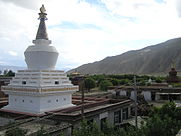





![Sanchi Stupa No.2, the earliest known stupa with important displays of decorative reliefs, c. 125 BCE[25]](https://upload.wikimedia.org/wikipedia/commons/thumb/9/91/Sanchi_Stupa_number_2_KSP_3660.jpg/200px-Sanchi_Stupa_number_2_KSP_3660.jpg)
![East Gateway and Railings of Bharhut Stupa. Sculptured railings: 115 BCE, toranas: 75 BCE.[23]](https://upload.wikimedia.org/wikipedia/commons/thumb/9/91/East_Gateway_and_Railings_Bharhut_Stupa.jpg/200px-East_Gateway_and_Railings_Bharhut_Stupa.jpg)
![The Great Stupa at Sanchi[26] Decorated toranas built from the 1st c. BCE to the 1st c. CE.[23]](https://upload.wikimedia.org/wikipedia/commons/thumb/b/b0/Sanchi1_N-MP-220.jpg/200px-Sanchi1_N-MP-220.jpg)

![A model resembling the Saidu Sharif Stupa, with square base and four columns (1st century CE).[29]](https://upload.wikimedia.org/wikipedia/commons/thumb/0/04/StupaWithPillarsGandhara2ndCentury.jpg/150px-StupaWithPillarsGandhara2ndCentury.jpg)

![A tower-shaped stupa, thought to be the design of the second (rebuilt) Kanishka Stupa, Jaulian monastery[33]](https://upload.wikimedia.org/wikipedia/commons/thumb/d/dd/Jaulian_Stupa_A11_reliquary.jpg/54px-Jaulian_Stupa_A11_reliquary.jpg)
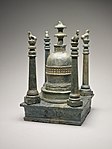
![Chilas petroglyphs, Buddhist stupa, c. 300–350 CE based on paleography[34]](https://upload.wikimedia.org/wikipedia/commons/thumb/6/65/Chilas_petroglyphs%2C_Buddhist_stupa_circa_300-350_CE.jpg/115px-Chilas_petroglyphs%2C_Buddhist_stupa_circa_300-350_CE.jpg)























